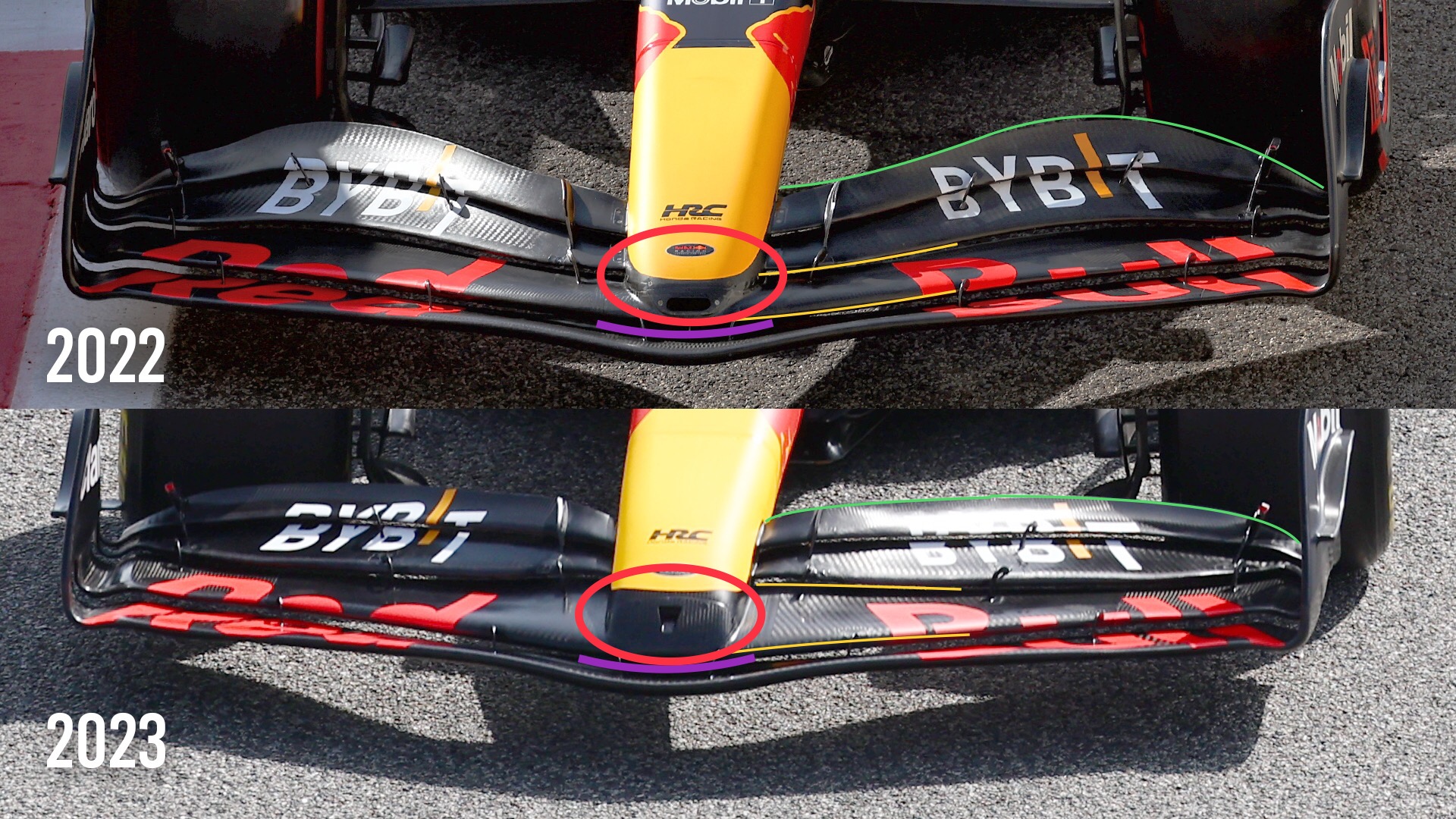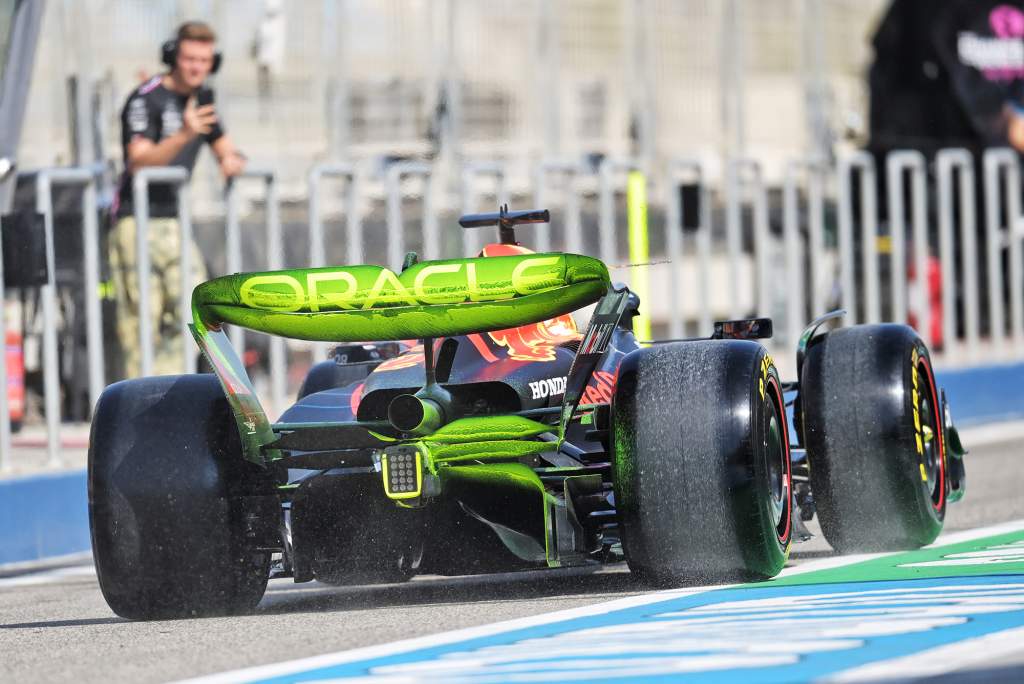Up Next

The 2023 Formula 1 car everyone had been waiting for has finally broken cover.
Red Bull’s RB19 is what you would call an evolution of the RB18. After the team’s success in 2022, when it won both championships, there is no reason for it to go out on a limb and take too many gambles.
That said, there are plenty of visual changes on the new Red Bull. But as we all know it’s changes that are not visual that make or break any car.
We have compared some late-season pictures of the RB18 from 2022 with the initial RB19 specification that has appeared for pre-season testing in Bahrain.
Starting at the front, the front wing is more uniformly loaded across its span (green highlight below) which will mean a more uniform airflow coming off the trailing edge leading to the sidepods. It still retains the full-width slot gap between the first and second element of the assembly which allows better airflow to the underside of the nose surface (magenta highlight below).

Even though the pictures are from slightly different angles it looks like the second element has increased in chord where it integrates with the nose (yellow highlights above). The chord length of each flap is determined by when the flow on the undersurface is getting a bit lazy and might need a supply of high energy flow from the top surface – where that happens is where you position the slot gap.
The nose itself is a little wider and flatter at the front where it supports the second element (red ellipse above). This could be for lots of reasons and it could be that it is a lighter, structural solution for the frontal impact test and, being slightly wider, a more stable mounting for the front wing. Anything to save weight is like gold dust on these cars.
The front suspension layout is similar to last year. Red Bull utilises a pullrod operated inboard spring medium (red highlight below). The wishbone and trackrod layout is again similar, across both the front leg of the lower wishbone and trackrod (yellow highlight below) and the rear leg (magenta highlight below).

As for the wishbone pick-up angles, again the pictures are at a slightly different angle but it does look like Red Bull has increased the top wishbone inboard pick-up angle, seen on the forward leg (green highlight above) and rear leg (blue highlight above). It was one of the only teams to take this detail to the level it did last year and if it can control the ride-height change during braking with this geometry it improves the consistency of the downforce the underfloor can produce.
The radiator intake is very similar. It appears to be slightly shallower and slightly wider but these are relatively small changes (light blue highlight above).

In side view the body lines are fairly similar if subtly different. The upper surface of the sidepod undercut is slightly different (blue highlight above). The blue arrow is pointing at the section that has changed. Obviously the cooling package and the side impact structures have to be contained inside these body surfaces so to some extent the body surfaces are compromised by all these mechanical components.
The closer shot of the sidepods below shows the change in the surface of this undercut section (blue highlight below). This change could relate to that need to incorporate the cooling package but it could also be just a simple change in how Red Bull wants to manage the airflow in that undercut area.
The increase of 15mm on height of the outer sides of the floor in this year’s rules means that you would want to have more of the airflow that comes in through the front suspension going into that undercut area to flow through into the coke bottle section where the bodywork comes inwards between the rear tyres.

Looking at it a bit closer the undercut is not that different (red highlight below) to 2022. It has a slightly different profile but volume-wise it hasn’t changed as much as it might seem.
The intersection of the side surface and the upper surface of the undercut (yellow highlight below) is slightly different and more abrupt but again this is probably a packaging requirement.

The Red Bull is the first car that’s allowed us to see the detail with which the team has gone about overcoming the regulation changes lifting the outer edges of the floor. It’s an area of the car that Red Bull appeared to understand very well last year and its initial attempt to tackle the 2023 change looks very comprehensive.
It has these two small strips (red arrows below) pulling airflow out from the front corner of the underfloor where the multiple underfloor splitters turn aggressively outwards. The flow coming in through the suspension (green arrows) will join up with this red flow, making up the blue flow going through into the coke bottle.

The white ellipse above highlights a small wing section. In itself it doesn’t do much for the sealing of the sides of the floor but what it does do critically is create a slot gap between the edge of the main part of the floor and its undersurface which in effect is the outer edge of the floor assembly. This means that when the sides of the floor get close to the ground it allows airflow through that slot, so it reduces the sensitivity of this area. To use my old example it makes the floor seal a bit more like a dimmer switch than an on/off switch.
Red Bull has been taking a close look at the flow in this area using flow-vis paint. It will compare this flow against its CFD predictions and I’m sure it will react with potential minor changes.
I would have thought it would have wanted to see the flow more like the red arrows that I have added on the image below. But again time will tell if we see any changes in that area.

The rear suspension is still pushrod operated (red highlight below) and the top wishbone is in a very similar position (blue highlight), as is the lower wishbone (magenta highlight). It’s very difficult to see the geometry in detail but nothing looks dramatically different from the previous version.
The biggest difference in this comparison is the beam wing and especially the upper flap trailing edge (yellow highlight below). In 2022 Red Bull had a beam wing design that was basically two separate wings and not the conventional two-element wing with a simple slot gap. In this year’s version, or at least this initial version, the beam wing is a more conventional two-element design.

Like its main competitors from 2022, Ferrari and on occasions Mercedes – who never really got the best from their cars last year – Red Bull has gone for evolution with its 2023 car. Yes, there are lots of detail changes but nothing that constitutes a philosophy change.
It will all be down to who had the most to gain from optimising what they had last year, and/or who had the most to gain from reliability tweaks related to the power units.
Will we know post-testing? As usual I doubt it very much but that won’t stop us – or especially me – from sticking our necks out and putting forward some performance predictions.




